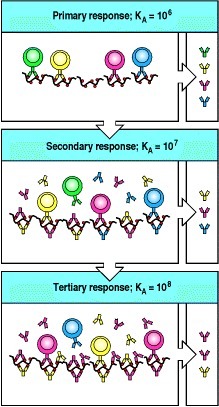FA16 Immunization Module’s Updates
Basis of Immunologic Memory
Immunologic memory is the ability of the immune system to react more quickly to an infection to which the body has previously been exposed to. Following the first exposure to an antigen a primary response is mounted. The immune system goes through all the steps of presenting antigen to naive lymphocytes, initiating clonal expansion and saving memory B and T cells for later reassurance of infection. This response is one of the hallmarks of the adaptive immune system, which allows the body to initiate much faster and higher quality secondary and possible tertiary responses to the same infection.
Memory can be acquired from either an infection or vaccination and is long lived. The maintenance of memory is interesting in that while most memory cells stay in a resting state, a small amount have been found to be actively dividing. While it is unclear what exactly causes these divisions in the absence of an active infection, it is known that cytokines also play a role in maintaining memory cells during the resting state.
In individuals with immunity to a certain antigen it is the memory cells that mediate the response. Naive lymphocytes do not contribute to secondary or subsequent responses. This inhibition of naive lymphocytes has been used to prevent Rh incompatibility in pregnant women by immunizing them so that their own naive lymphocytes fail to mount a response to the fetus' blood. Due to inactivating naive cells, this therapy must be performed before the first pregnancy to avoid the initial response to the fetal blood antigen.
Janeway, Charles A., and Jr. "Immunological Memory." Immunological Memory. U.S. National Library of Medicine, 2001. Web. 27 Sept. 2016.



Informative and concise review of immunologic memory. In context of vaccines that have to be given several times over the course of a person's lifetime, why do these certain memory cells lose effectiveness while others do not?